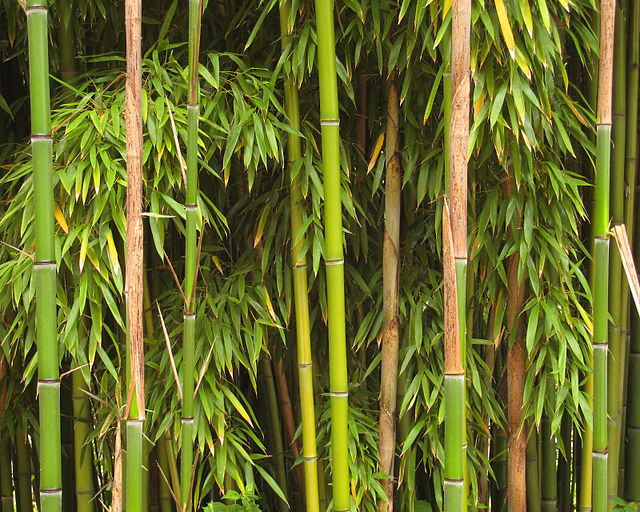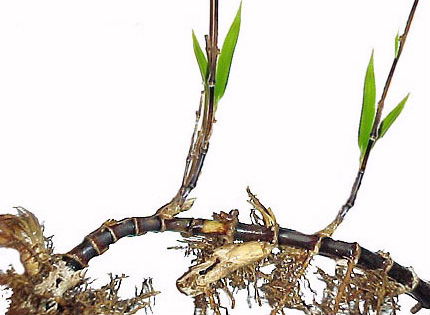Bad Bamboo
by Ray Novitske, Fairfax Master Gardener
 Beginning on January 1, 2023, it will be illegal for your Running Bamboo to spread from one property onto a neighbor’s property or public right of way. The responsibility to contain it will fall on the property owner where the bamboo is growing. The law will be enforced by the county’s Department of Code Compliance, and fines will range from $50 to $2000.
Beginning on January 1, 2023, it will be illegal for your Running Bamboo to spread from one property onto a neighbor’s property or public right of way. The responsibility to contain it will fall on the property owner where the bamboo is growing. The law will be enforced by the county’s Department of Code Compliance, and fines will range from $50 to $2000.
Not all bamboo is the same. There are two types: clumping and running. The clumping bamboo is not invasive and is relatively easy to control. It is the running bamboo causing the problems because of its invasive nature. For information on acceptable ornamental clumping bamboo, see our story references at the end of this page.
There are several species of running bamboo that are considered invasive in the U.S. An invasive here is defined as a plant that spreads quickly because of its vigorous growth, outcompeting native vegetation and that harms the natural ecological balance of native animal and plant species.
Bamboo Botany Lesson
Bamboo is classified as a grass, albeit with woody characteristics. The upright culms (stalks or canes) can grow from 20 to 50 feet (6 to 15 m) in height. In the spring growing season between March and May, they can shoot up several inches in one day, as it is the fastest growing plant in the world. Culms reach their mature height in their first year of growth. The leaves grow out year to year as some are lost and are replaced, and some species lose their leaves entirely every winter. But it is the root system that causes so many problems.
The root system of rhizomes can grow up to 15 feet (5 m) horizontally in one year. Each rhizome can sprout several culms upward to grow with leaves to produce food for the next year’s growth. The oldest, strongest rhizomes will produce the strongest, thickest culms. But each spring, the newest culms grow thicker and taller than previous years.
Control the Beast
A bamboo clump is difficult to control, but methods include trying to contain its growth and spreading through use of barriers and trying to eradicate it. Control of mature stands of bamboo is extremely difficult. The concept is to provide a physical barrier that prevents the rhizomes and roots from spreading past a certain point: essentially a wall below grade.
Three-foot long (1 m) solid barriers below ground are sunk vertically as a wall past which no rhizomes can grow. Obviously, this material needs to be strong, solid, and without any open seams. Researchers suggest thick polypropylene or polyethylene as appropriate materials. Porous materials such as wood, plastics, concrete or steel are not reliable barriers. The work to install these barriers can be extensive, and they are not foolproof. Roots have been known to grow under or over them after installation.
An open air 3-foot deep (1 m) trench is also suggested as a barrier. This however can create a physical tripping hazard, be unsightly and be time-consuming to upkeep due to its tendency to fill in from erosion. Any rhizomes and roots growing through the trench must be immediately trimmed, so this control method requires constant observation and maintenance.

Running bamboo rhizome
Sometimes, running bamboo spread can be slowed or stopped by physically preventing the culms from growing as they emerge from the ground in spring and summer. This deprives the plant of producing new leaves to manufacture and store food for more growth. Energy stores in the roots and rhizomes are used to sprout new culms, so preventing photosynthesis in new leaves forces the plant to eventually weaken and die.
Constant vigilance is needed for this method to succeed. And as long as a neighbor leaves bamboo growing, there will always be new culms sprouting up from rhizomes 15 feet away (5 m). Cut them off as they emerge or kick them over. This will prevent the culms from growing and slow the bamboo down but will not stop the rhizomes from spreading underground.
Excavation and removal of the rhizomes and root system is another way to physically eradicate bamboo. This usually cannot be done by hand and requires a professional landscape company to utilize power equipment for excavation to lift the rhizomes out of the soil after culms are cut and removed. Problems such as damage to other landscape plants, soil compaction and necessary regrading might need addressing after such an operation. Any rhizomes remaining will regrow.
Lastly, there are chemical herbicides that might be used, but again are not always effective. The bamboo must be first cut down as much as possible. Within 5 minutes, a systemic chemical herbicide needs to be applied in sufficient concentrations to do the job. These are generally stronger versions of those used normally by us home gardeners. As with most chemicals, there is a potential to harm adjacent plants through drift and spray, and to damage wetlands and water through runoff from the application. The higher concentrations of the chemicals needed to be effective on bamboo requires more caution. The herbicides are most effective when applied from mid-September to mid-October with repeated application in 14 days.
Afterwards, consider alternatives to replace any running bamboo removed. Clumping bamboo, ornamental grasses and native grasses all make appropriate substitutes and help restore the balance in our ecosystem of animals, birds, insects and plants.
References
• Containing and Removing Bamboo, University of Maryland Extension
• Pest Management Guide, Weed Management in Home Ornamental Beds, Virginia Cooperative
Extension
• Running Bamboo, Fairfax County VA publication
• Running Bamboo, Fairfax County Virginia
• Graminoids: Grasses and Grass-Like Species (Order Poales), Mid-Atlantic Invaders Tool
• Have No Fear Bamboo, George Graine, Fairfax Master Gardeners
• Installing a Bamboo Barrier, University of Maryland Extension, YouTube